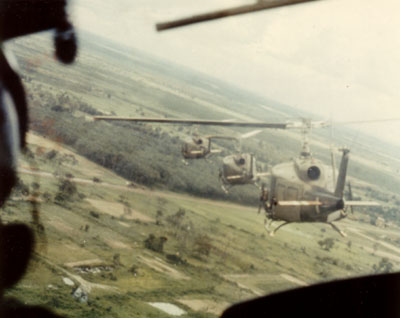The First Team in the ‘Nam
Destiny Takes a Hand
So the arrival of the 1st Cavalry Division to Vietnam was propitious. Even as they began establishing their base at An Khe, the North Vietnamese began making their final moves for a takeover of the country. Three full regiments were enroute to the Highlands of Vietnam. Their goal was to take Pleiku, control the east-west highway and sever South Vietnam in two parts.
The coming of the AirCav, however, would change all of that. Their purpose was to four-fold. They were to find, fix, fight and finish the enemy. They would do all four and do them well. The 1st Cavalry Division (Airmobile) came to Vietnam to spread its wings and do its job. It remained there until April 29 1971, when the last units departed for Fort Hood.
Undoubtedly the First Team made the strongest impact of any single unit on the Vietnam War. Times have changed. The First Cavalry Division of today is both airmobile and armored: a lesson learned in Vietnam. The legacy brought from the past has made this unit one of the finest in the United States Army.
{default}
One of the great assets of the division was its leadership. During the period of nearly six years it enjoyed the leadership of eight outstanding generals. George W. Casey, who commanded the unit in 1970, was killed in a helicopter crash after setting out to visit some of his wounded men at the hospital at Cam Ranh Bay. The wreckage was found on July 9th in the mountains of Vietnam. He had written a congratulatory letter to the men under his command just prior to making the flight. It was addressed “to the SKYTROOPERS of the 1st Air Cavalry Division.â€
After citing numerous specific examples of courage and team spirit, and mentioning some of the major accomplishments achieved by the AirCav, he concluded his tribute with these words:
“This is your achievement. This is yet another demonstration that you of the 1st Air Cavalry Division deserve – and have earned again – the accolade of the FIRST TEAM. It is my honor to have served alongside you during this crucial and historic period.â€
This tribute tells it all. They went and they did their job. They did their duty. Long live the Skytroopers!
Author Information
Wild Bill Wilder, a native of Atlanta, Georgia, was introduced to modern warfare as a tot in World War II when his father and uncle went off to war in the USAAF. It was an experience that influenced him greatly throughout his life. After graduating from Toccoa Falls College in 1962, he spent the next 10 years in public service in various countries in Central America. He then worked in public transportation until his retirement in 1999.
Wild Bill now has even more time to dedicate to his passion – wargaming. In 1997 he formed a group called "Wild Bill’s Raiders." From small beginnings the Raiders expanded into five separate web sites and gave top-notch coverage to a number of popular wargames.
Bill has also been a vital part of the production of 13 different games, including SPWAW, Combat Mission, The Operational Art of War, and John Tiller’s Squad Battles series. He has authored over 1300 scenarios and campaigns for these and other games over the last nine years. At age 68, Bill is also a prolific writer, with his primary focus on warfare of the 20th century. To quote him, "Wargaming is a passion that never dies with the passing of the years. Instead it only intensifies as new and better wargames are produced. It is in military history that one finds often written in blood the glory and the grief of mankind!"

